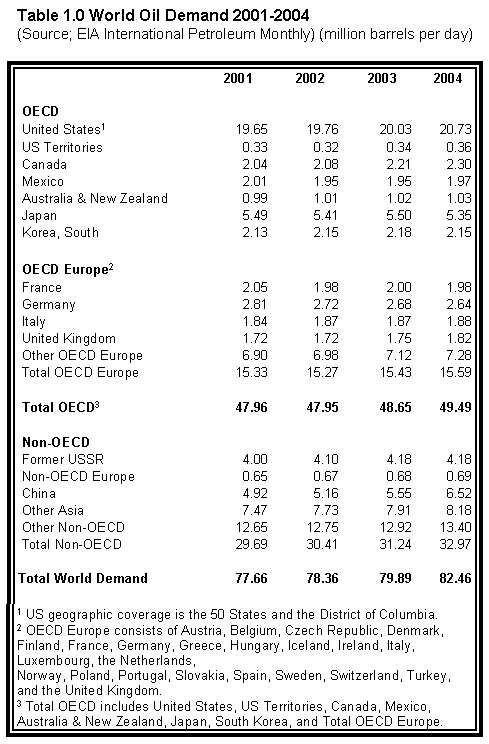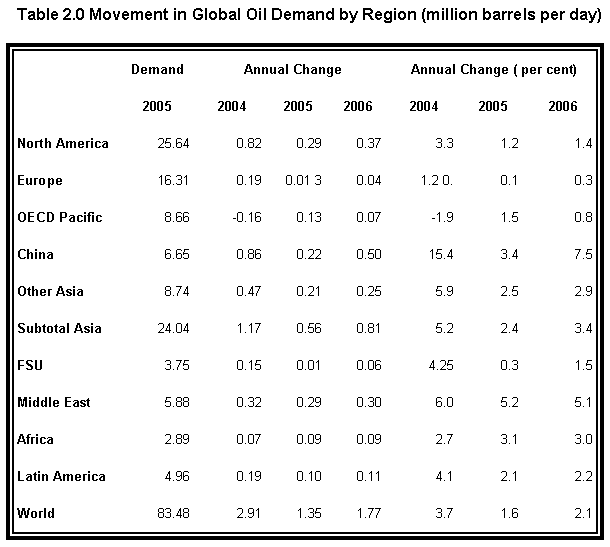China is presently producing oil at a relatively high and efficient rate. Although its remaining oil resources appear substantial, most are located in remote or offshore regions of complex geology that will make recovery expensive and technically difficult. Consequently continuing increases in China’s already significant oil production are uncertain. Even more doubtful is the IEA projection that, overall, non-OPEC countries can increase their oil output by about 5 million barrels a day over the next 15 years, given expected production declines in the United States, Canada, and the North Sea.


Advertisement
Long term supply: possible scenario
Assuming the world annual oil consumption rate of about 33 billion barrels for 2004 continues to grow at about 2 per cent annually (Table 2.0), the world will would consume all of the optimistically estimated 2.3 trillion barrels of recoverable oil well before the end of the first half of this century.
Not to travel too far into the future we would expect to near the 100 million barrels a day in 2010 projected by IEA, to achieve this OPEC alone would be expected to increase its oil production from the present 30 million barrels a day to as much as 45 million barrels a day. An increase by 15 million barrels a day is achievable through countries like Saudi Arabia and Iraq (with substantial investment). This will result in OPEC producing more than 50 per cent of the world’s oil; bringing the world even more under the mercy of OPEC price and production control.
However, OPEC has no current plans to increase oil production beyond the present level. Enormous investments will be necessary to jump to that level of production and such expansion would require expertise, equipment and investment which will need to come from the West. The possibility of such a scenario taking place is extremely low with the current political atmosphere in “most” parts of the OPEC. Taking Saudi Arabia as the most likely candidate to play the leading role for such an increased magnitude of oil production, their ability to fund an investment of this scale is questionable. The country is recovering from a deficit and its monetary reserves maybe insufficient to do it independently. Asking the West to invest ten’s of billions of dollars in the current political atmosphere would be unpalatable.
The second possible country that has significant potential to increase production in the long term is Iraq. It possesses the world’s second largest proven oil reserves, currently estimated at 112.5 billion barrels - about 11 per cent of the world total - and its gas fields can easily add 5 million barrels a day to the market. With the lack of security and political stability any major foreign investment will be unthinkable.
In general the obstacles to short-tem development are not geologic but political and or regulatory, that is to say, transient.
Oil’s not well - life after petrol
Having decided there will be less oil to share, let us first review some of the frequently mentioned alternatives and some of the major issues associated with their wide-spread use in vehicles:
Advertisement
- Hydrogen - great for fuel cells and internal combustion (IC) engines as its use only produces water as waste. There is significant support for pursuing the “Hydrogen Economy” as an alternative, some even suggesting we should use existing gas resources to produce hydrogen. However it has problems with storage and also with production efficiency unless produced from some form of renewable energy like wind power. Hydrogen becomes inefficient in terms of energy usage if made from natural gas.
- Electric power - fuel cells are making progress and if adapted to use natural gas directly show significant promise providing of course we can easily and conveniently carry gas. Compressed Natural Gas (CNG) is feasible but currently the bottles are heavy and bulky, decreasing vehicle load carrying capacity. A similar problem exists with batteries in that they are heavy and bulky with the added problem of taking some time to recharge.
- Natural gas powered IC engines - this is not a new concept and has been in operation for many years, again the bulky and heavy storage bottles make it unpopular. Liquefied Natural Gas (LNG) provides a better, more compact system, as the volume of fuel for the same energy value only occupies one third of the space of CNG. However cryogenic equipment is necessary, creating a whole new set of practical and safety issues, particularly for filling and storing on board.
- Ethanol - appears to be an option provided that engines are built to use this fuel and we can grow sufficient crops to meet demand.
- Synthetic liquid fuel from gas (GtL) - a significant possibility which has been researched for many decades, unfortunately, as with hydrogen production from gas, the processes developed so far consume a significant percentage of the energy supply (gas).
When we review these alternatives we see that natural gas could play a significant part in four of the five broad options. But what if we could provide the gas in a directly usable form without the need for high pressure or cryogenic storage? What if we could provide “gas” in a convenient stable form that is safe to handle and easy to manufacture?
Current estimates indicate the total reserves of natural gas, including those locked away as natural gas hydrate, can supply the world’s energy needs for centuries. So if we can make natural gas more “user friendly” as a transport fuel we have the opportunity to completely change the nature of personal transport fueling systems.
So what could we use that fulfils these criteria? Synthetic Natural Gas Hydrate (SNGH) comes very close. With the novel system developed in Australia, SNGH can be produced “instantly” in a continuous flow. It is a white ice-like solid that is stable at moderately low temperatures (about -5C) and at atmospheric pressure, with an energy per unit volume similar to that of CNG. This energy form has an advantage over liquid fuel in that it is an extremely safe product. If subjected to an ignition source while in the solid state it will ignite but can be easily extinguished much like a candle, so in the event of a spillage one merely has to scoop it back into a cold container.
Other groups (notably the Japanese and Americans) are also pursuing this novel form of storage and transport of natural gas. The technology is well advanced to process and transport existing reserves of natural gas, the real challenge will be to economically commercialise the gas trapped in gas hydrates for the long-term supply and to facilitate the change in distribution technology to handle solid fuel.
Discuss in our Forums
See what other readers are saying about this article!
Click here to read & post comments.
1 post so far.